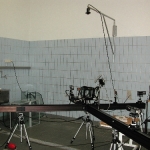Click on the images to obtain further details about this equipment.
We have developed a unique silhouette (shadow) video photography (SVP) system for making behavioural observations of small aquatic organisms.
SVP is superior to standard cinegraphic or video imaging techniques because it allows filming of events in a large depth of field (~15-30 cm), with a field of view limited only by the size of the lenses used. Magnification is independent of distance from the cameras, the resolution is very good (objects as small as 0.2 mm can be resolved), and image quality is unaffected by ambient light level.
In addition, the system does not require intense light sources so that animals can be observed in near natural conditions, including darkness using only a far-red, low intensity LED (output < 10-6 W cm-2). Analysis of the images obtained from the SVP system allows for detailed characterization of the reactions of aquatic organisms to different environmental conditions.
This type of analysis provides us with information on overall activity, swimming patterns, foraging and prey search behaviours. All of these are directly relevant, and of great importance, in developing appropriate rearing environments. Such observations can be used very effectively in order to evaluate different combinations of rearing conditions.
You can read all about our SVP system, and associated software, in the Methods section of this article:
Browman, H.I., J.-F. St-Pierre, A.B. Skiftesvik & R.G. Racca. 2003. Behaviour of Atlantic cod (Gadus morhua) larvae: an attempt to link maternal condition with larval quality. pp: 71-95, In: H.I. Browman and A.B. Skiftesvik (Editors). The Big Fish Bang. Proceedings of the 26th Annual Larval Fish Conference.
Read the article
All of these movies were generated using our unique silhouette imaging system which is presented and explained here.
The following book contains useful information on the imaging techniques that we use:
Settles, G.S. (2001). Schlieren and Shadowgraph Techniques. Visualizing Phenomena in Transparent Media. Springer-Verlag, Berlin, ISBN: 3-540-66155-7




